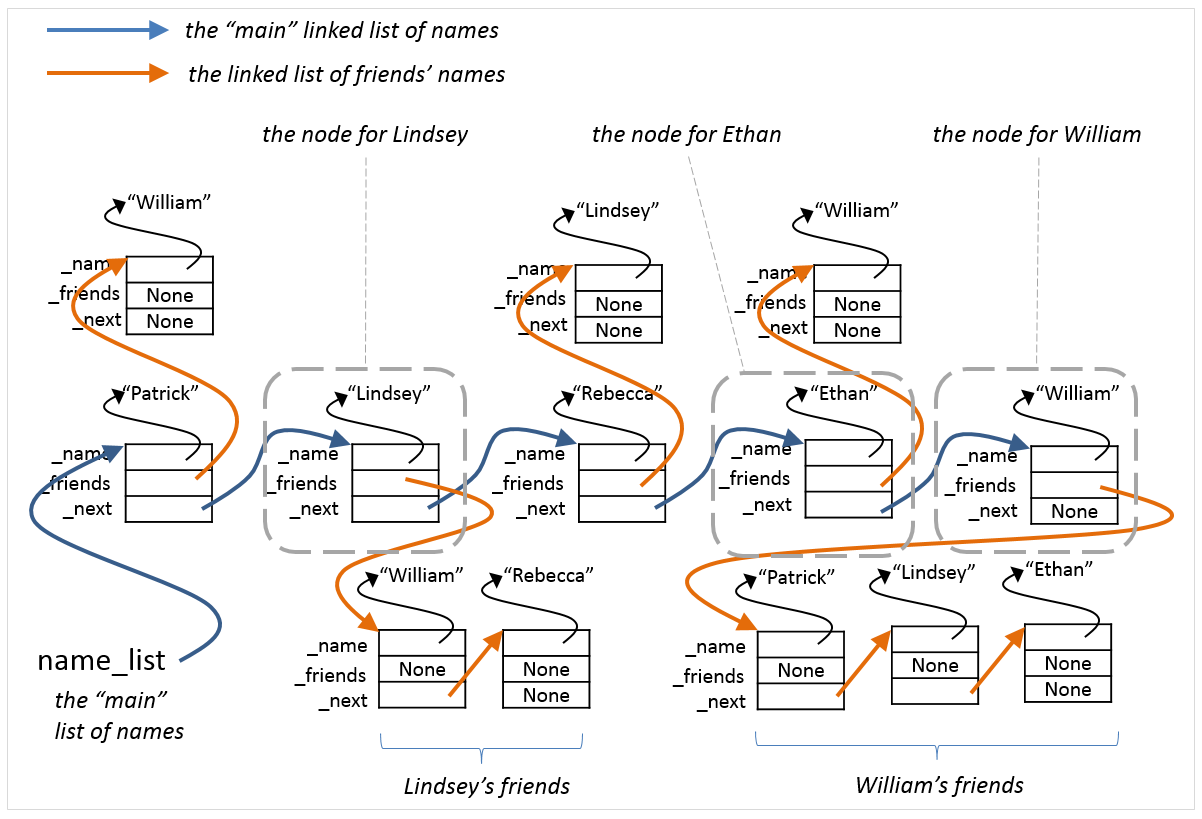
CSc 120: Friends
The primary purpose of this problem is to work with linked lists.
Background
Social media sites often look at what you have in common with your
friends (or followers, or contacts) to make suggestions. As an example,
Facebook and LinkedIn will point out "mutual friends", i.e.,
people whose friends have one or more people in common with yours.
This problem involves implementing a simple form of an algorithm for
identifying such mutual friends.
Expected Behavior
Write a Python program, in two files linked_list.py and
friends.py, that behaves as specified below.
The file linked_list.py should contain code implementing
the LinkedList and associated classes while
friends.py should contain code that uses these classes
to implement the functionality required of this program. At the top your
friends.py file, include the following statement so that you are able to use the classes in your linked list file:
from linked_list import *
Your program should behave as follows.
-
Read in the name of an input file using input('Input file: ').
Read in the contents of this file into your program, e.g, as a list.
-
Organize the data, which specify friendship relationships between pairs of
names, and organize the data as specified under Data structures below.
NOTE: Friendships are two-way relations (in mathematics, such relations
are called
symmetric). This means that for each input line
of the form
X Y
you should set up your data structures to indicate two things:
-
X is a friend of Y; and
-
Y is a friend of X.
-
Read in two names using the function calls below. You can use other variable names
or your choice to store the values read in. Strip off whitespace as necessary.
name1 = input('Name 1: ')
name2 = input('Name 2: ')
-
If there are friends in common, first print the following line:
Friends in common:
Then print out the name of each mutual friend of name1 and
name2, i.e., any name3 such that
name3 is a friend of both name1 and
name2 (see Output format below). Names can be printed in any order.
If there are no friends in common, no further output is produced. (That is, if there are no
friends in common, the program only produces the input prompts.)
Input format
Each line in the input file consists of two strings separated by whitespace
(blanks and tabs). E.g.: the file
in04 is:
William Ethan
Rebecca Lindsey
William Lindsey
William Patrick
You should not make assumptions about the amount of whitespace around and
between names.
Output format
Names of mutual friends should be printed out one per line, in any order, using the
following statement:
print(name)
Data Structures
The names read in should be organized as a linked list with a
node per name.
Each node should have the following attributes:
-
a name (a string);
-
the friends for that name (a linked list); and
-
a reference to the next node.
For example, for the file in04
mentioned above (under Input format), the data structure should
be as shown below:

(click on the image for a larger picture)
Programming Requirements
Your program should use linked lists to implement:
-
the list of the names read in from the input file; and
-
for each such name, the list of that person's friends.
Your code should be organized among your files as follows:
-
linked_list.py: Code to implement the
linked list class.
-
friends.py: Code that uses methods from
the linked list class to implement the application required by
this assignment.
The methods defined in linked_list.py can be accessed
in friends.py using an import statement
in the latter file.
Errors
In order to facilitate grading, we will use specific error messages in this
assignment, as indicated below.
The following are errors:
-
Input file cannot be read.
Program behavior: Use a try statement to detect this.
Give the following error message and quit.
Error message:
"ERROR: Could not open file " + filename
-
One or both of the names name1 or name2
cannot be found in the list of names. (Read in both names first. Check for name1 first and name2 second. At most one name will be unkown.)
Program behavior:
Give the following error message and quit.
Error message:
"ERROR: Unknown person " + name
The tester will fully exercise all error cases that we expect you to handle. In other words, if you pass all error-producing tests, you can assume your error handling is fully correct and complete.
Examples
Some examples are shown
here.

